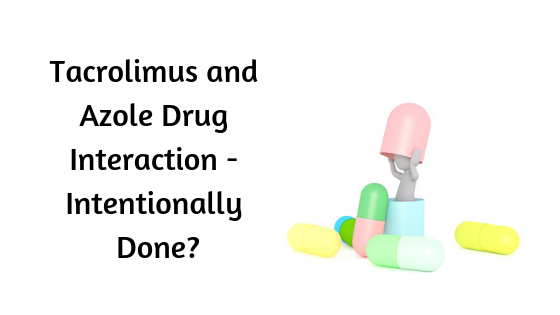The tacrolimus and azole drug interaction is a concerning one that needs to be monitored. In this case, the drug interaction was actually used to the benefit of the patient. I’m greatly appreciative of this guest post/case from Amanuel Tseggai, PharmD, BCPS!
This case involves a 58-year-old African American gentleman with a history of diabetes, hypertension s/p renal transplant 8 months ago. In this situation, the tacrolimus and Azole drug interaction was taken advantage of for clinical purposes.
As per the progress note
Tacrolimus is a macrolide calcineurin inhibitor used in most immunosuppressant regimes following solid organ transplantation.
A day before hospital admission, the patient presents to his clinic complaining of abdominal pain , nausea and diarrhea of 3 –day duration. Further examination and laboratory analysis reveal the presence of skin rash and an elevated bilirubin (55mg/dl), elevated serum creatinine (2.6mg/dl) and sub therapeutic Tacrolimus level (3.3 ng/ml: therapeutic range set at 5-15 ng/ml)
Patient was clinically stabilized with Baciliximab, a monoclonal antibody and corticosteroids per hospital protocol yet remained hospitalized. His tacrolimus regimen was restarted at a more aggressive dose after being held for a few days yet continued to remain low ( in a range of 2.9 – 3.7ng/ml) over the course of 5-6 days despite the increase in dose.
On Day 10 post admission, a new antifungal agent: Ketoconazole 400mg PO daily, was initiated. Ketoconazole, an imidazole antifungal drug, can interact with tacrolimus and cyclosporine through inhibition of cytochrome P450 microsomal enzymes in the liver, leading to inhibition of tacrolimus and cyclosporine metabolism and subsequently increasing their blood levels. Given that azoles are widely prescribed in immunocompromised patients due to high risk for fungal infection, the initiation of Ketoconazole causes no major alarm. However, the major interaction it possesses with tacrolimus in which it can significantly increase tacrolimus level certainly raises some concern.
That being the case, the emergence of ketoconazole to the patient’s regimen was primarily to do with trying to best manageing his persistent low tacrolimus level. Even with the absence of positive fungal infection, the drug will certainly be beneficial prophylactically. It’s a sort of “killing two birds with one stone” scenario.
Two days after initiating Ketoconazole therapy, patient’s tacrolimus level started to gradually increase where it eventually reached a therapeutic level (6.7ng/ml) after several days.
The moral of the story is…a few drug-drug interactions can be a blessing in disguise and, as in this case, may have some clinical benefits. Here’s another azole interaction you need to be aware of.
Amanuel Tseggai, PharmD, BCPS



“The initiation of ketoconazole causes no major alarm”.-Really? I sit up strait and pay attention in the extremely rare instances this medication is used. The FDA all but banned the oral ketoconazole in a 2016 Safety Communication. Here’s an excerpt.
The U.S. Food and Drug Administration (FDA) is taking several actions related to Nizoral (ketoconazole) oral tablets, including limiting the drug’s use, warning that it can cause severe liver injuries and adrenal gland problems and advising that it can lead to harmful drug interactions with other medications. FDA has approved label changes and added a new Medication Guide to address these safety issues. As a result, Nizoral oral tablets should not be a first-line treatment for any fungal infection. Nizoral should be used for the treatment of certain fungal infections, known as endemic mycoses, only when alternative antifungal therapies are not available or tolerated.
Back in 2016 the FDA sent a warning against the routine use of Ketoconazole for the treatment of skin and nail infection due to its potential to cause ‘severe liver damage’ longterm. However, it’s not uncommon to see the drug prescribed for systemic infection short term, especially in transplant patients with good hepatic panel. Certainely, there needs to be a valid clinical reason it’s chosen over the other azoles with minumum toxicity profiles.
As the title of the subject indicates, the primary driving force for adding Ketoconazole to this patient’s regimen is related to its potent Cytochrome inhibitory property in bringing tacrolimus to its desirable therapeutic level. And it is short term.